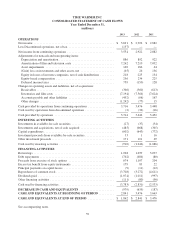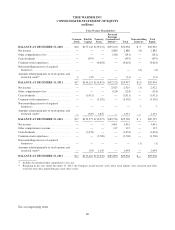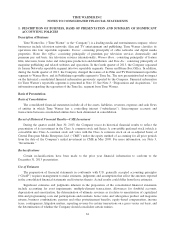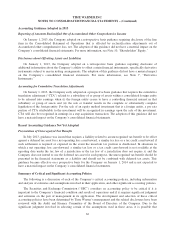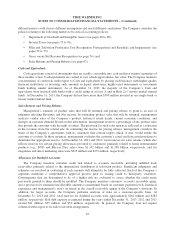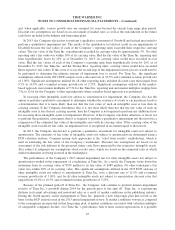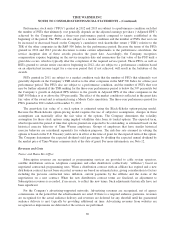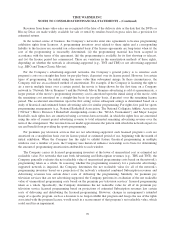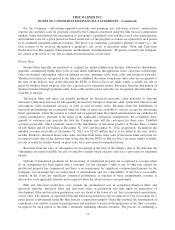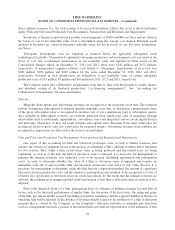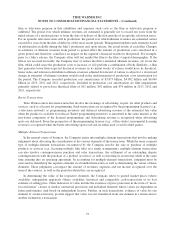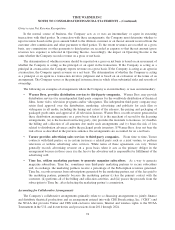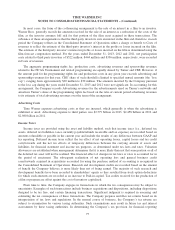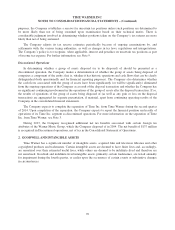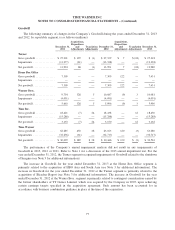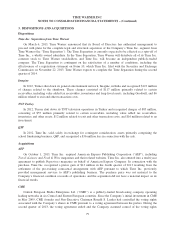Time Magazine 2013 Annual Report Download - page 85
Download and view the complete annual report
Please find page 85 of the 2013 Time Magazine annual report below. You can navigate through the pages in the report by either clicking on the pages listed below, or by using the keyword search tool below to find specific information within the annual report.TIME WARNER INC.
NOTES TO CONSOLIDATED FINANCIAL STATEMENTS – (Continued)
Performance stock units (“PSUs”) granted in 2012 and 2013 are subject to a performance condition such that
the number of PSUs that ultimately vest generally depends on the adjusted earnings per share (“Adjusted EPS”)
achieved by the Company during a three-year performance period compared to targets established at the
beginning of the period. The PSUs are also subject to a market condition and the number of PSUs that vest can
be increased or decreased based on the Company’s cumulative total shareholder return (“TSR”) relative to the
TSR of the other companies in the S&P 500 Index for the performance period. Because the terms of the PSUs
granted in 2012 and 2013 provide discretion to make certain adjustments to the performance calculation, the
service inception date of these awards precedes the grant date. Accordingly, the Company recognizes
compensation expense beginning on the service inception date and remeasures the fair value of the PSU until a
grant date occurs, which is typically after the completion of the required service period. These PSUs, as well as
RSUs granted to certain senior executives beginning in 2012, also are subject to a performance condition based
on an adjusted net income target for a one-year period that, if not achieved, will result in the forfeiture of the
awards.
PSUs granted in 2011 are subject to a market condition such that the number of PSUs that ultimately vest
generally depends on the Company’s TSR relative to the other companies in the S&P 500 Index for a three-year
performance period. The PSUs also are subject to a performance condition, and the number of PSUs that vest
may be further adjusted if the TSR ranking for the three-year performance period is below the 50th percentile but
the Company’s growth in Adjusted EPS relative to the growth in Adjusted EPS of the other companies in the
S&P 500 Index is at or above the 50th percentile. The effect of the market condition is reflected in the grant date
fair value of the award and is estimated using a Monte Carlo simulation. The three-year performance period for
PSUs granted in 2011 ended on December 31, 2013.
The grant-date fair value of a stock option is estimated using the Black-Scholes option-pricing model.
Because the Black-Scholes option-pricing model requires the use of subjective assumptions, changes in these
assumptions can materially affect the fair value of the options. The Company determines the volatility
assumption for these stock options using implied volatilities data from its traded options. The expected term,
which represents the period of time that options granted are expected to be outstanding, is estimated based on the
historical exercise behavior of Time Warner employees. Groups of employees that have similar historical
exercise behavior are considered separately for valuation purposes. The risk-free rate assumed in valuing the
options is based on the U.S. Treasury yield curve in effect at the time of grant for the expected term of the option.
The Company determines the expected dividend yield percentage by dividing the expected annual dividend by
the market price of Time Warner common stock at the date of grant. For more information, see Note 12.
Revenues and Costs
Turner and Home Box Office
Subscription revenues are recognized as programming services are provided to cable system operators,
satellite distribution services, telephone companies and other distributors (collectively, “affiliates”) based on
negotiated contractual programming rates. When a distribution contract with an affiliate has expired and a new
distribution contract has not been executed, revenues are based on estimated rates, giving consideration to factors
including the previous contractual rates, inflation, current payments by the affiliate and the status of the
negotiations on a new contract. When the new distribution contract terms are finalized, an adjustment to
Subscription revenues is recorded, if necessary, to reflect the new terms. Such adjustments historically have not
been significant.
For the Company’s advertising-supported networks, Advertising revenues are recognized, net of agency
commissions, in the period that the advertisements are aired. If there is a targeted audience guarantee, revenues
are recognized for the actual audience delivery and revenues are deferred for any shortfall until the guaranteed
audience delivery is met, typically by providing additional air time. Advertising revenues from websites are
recognized as impressions are delivered or the services are performed.
69


